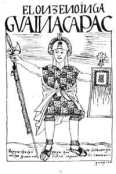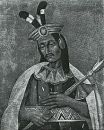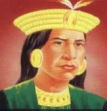Hello! This is part twenty two of a multi-part series on the Inca Empire and the Conquistadors. If you want some background, the introduction to this series is right here, and part twenty one is here. For those of you who like to have no idea what’s going on, go ahead!
Nunez Vela, outnumbered and unpopular, then made an even worse mistake. He had quarreled with a popular judge in Lima on multiple issues, and the imminent arrival of Gonzalo and the desertion of his soldiers seems to have stressed Nunez Vela past the point of reason. Late one night Nunez Vela called the judge into his chamber and accused him of being a traitor. The conversation quickly grew heated and a struggle broke out, and Nunez Vela stabbed the judge in the heart. (de la Vega loc. 23292)
Now the city of Lima turned against Nunez Vela, and as he prepared the city’s defenses a conspiracy against him began to form. The leading citizens of Lima arrested Nunez Vela, planning to send him back to Spain. Nunez Vela was placed in chains under heavy guard in a galleon that would take him back to Spain, but as the ship left the port of Lima the captain revealed that he had been loyal to Nunez Vela the whole time and freed the viceroy. Freed from the angry citizens of Lima and temporarily out of reach of Gonzalo, Nunez Vela plotted a course north to Tumbez, where loyal royalist troops were stationed.
Gonzalo rode into Lima hot on the heels of Nunez Vela, only to discover that his enemy had fled. Lima’s soldiers and citizens flooded to Gonzalo as we entered the city, and soon his army had tripled to 1200 men. Gonzalo was now the most powerful man in Peru, and no one had an army to equal his. However, Gonzalo still had no official title, so he immediately demanded that the judges declare him governor of Peru.
The judges, who had previously turned on Nunez Vela, were now in an uncomfortable spot with their savior. They tried to stall for time and equivocate. Gonzalo was known among the Spaniards as a compassionate and kind leader, but his second-in-command Francisco de Carvajal had no such reputation.
Carvajal immediately seized the judges and hung three of them in front of all the rest. Carvajal mocked the judges as he hung them, telling the most respected of the judges, Pedro del Barco that he respected him so much, he would allow del Barco to pick which branch he would like to be hung from. Finally Carvajal told all the judges that if Gonzalo was not declared governor, he would hang all of them and his men would sack the city. Unsurprisingly, the judges immediately declared Gonzalo governor (de la Vega loc. 23609).
In October 1544, Gonzalo Pizarro was declared governor of Peru, a post last held by his older brother three years ago. There was only one final item Gonzalo needed to take care of – Nunez Vela.
Landing in Tumbez, Nunez Vela immediately sent a call out to all loyal Spaniards to aid him in defeating Gonzalo’s rebellion. Men from Puerto Viejo, San Miguel and Trujillo flocked to his banner (de la Vega loc. 23819). However many other men left to support Gonzalo, and the north of Peru was a poor, inhospitable place, so many of the men coming to support Nunez Vela were poorly equipped.
Gonzalo decided to lead an expedition against the viceroy himself. While the majority of Peru supported Gonzalo, the newest governor of Peru knew that Nunez Vela still held the favor of the king of Spain. Gonzalo needed to kill Nunez Vela quickly, before reinforcements could come from Spain. Gonzalo raised an army of 600 veterans and marched north from Lima towards Tumbez.
As Gonzalo marched north, pushing his men hard as they marched through rough territory, they finally encountered the viceroy’s army of 150 soldiers outside the town of San Miguel (modern-day Piura). Faced with a clearly superior force, Nunez Vela ordered a retreat. Nunez Vela ordered his men to march for Quito, in modern-day Ecuador, a well-supplied, fortified city which was loyal to the viceroy. The only issue was that Quito was more than 500 miles away, and his men would have to retreat with Gonzalo’s men hot on their heels.
Nunez Vela’s men began a grueling retreat from Gonzalo’s men, feet churning up the road as they struggled to stay in front of Gonzalo’s men. As they marched Nunez Vela’s men fell to the ground from exhaustion, captured or killed by Gonzalo’s men as they were captured (de la Vega loc. 23977) . Gonzalo’s men suffered as well, because Nunez Vela’s men ate all the food from the surrounding areas, leaving Gonzalo’s men to chase them through barren and desolate areas. Gonzalo, for his part, ordered Carvajal to take 50 men and race ahead of Gonzalo’s main force, harrying Nunez Vela’s force. Carvajal’s 50 men couldn’t fight Nunez Vela’s 150, but they could stay close enough to Nunez Vela that the viceroy’s men could never rest properly, increasing the strain on Nunez Vela’s men horribly.
After a grueling retreat they finally reached the city of Quito, but Gonzalo’s men were so close behind that Nunez Vela had to continue retreating, finally escaping to Popayan in modern-day Colombia. In Popayan Nunez Vela began to raise men again from his supporters in the north.
Gonzalo, meanwhile, was worried. He could not invade Popayan, as his men and their supplies had been stretched to the breaking point already. However, he couldn’t leave Nunez Vela alive, or else the viceroy would invade from the north as soon as he had sufficient forces. Finally Gonzalo decided upon a plan. Gonzalo spread a rumor that he was heading south to suppress a royalist rebellion in Los Charcas, leaving only 300 men to safeguard Quito. The viceroy’s spies soon picked up on the rumor, and carried word of it back to the viceroy. Gonzalo then gathered 600 of his men and began to march south. (de la Vega loc. 24442)
Nunez Vela swallowed the bait entirely, leading his 400 men south towards Quito, planning to seize the city in a lightning-fast strike. Once he was in too close to retreat Gonzalo turned his troops around and raced back to Quito. On January 18, 1546 outside Quito, Gonzalo’s 900 men faced Nunez Vela’s 400.
The battle was a foregone conclusion. Gonzalo had outmaneuvered Nunez Vela, and his troops were better equipped and more experienced than Nunez Vela’s outnumbered men. Gonzalo’s skirmishers slaughtered Nunez Vela’s, and Gonzalo’s cavalry routed the viceroy’s on the right flank. Nunez Vela fought bravely, striking down several of Gonzalo’s soldiers, but he was doomed. A soldier brought a battle axe crashing down on Nunez Vela’s head and the viceroy was sent tumbling off his horse. The rest of Nunez Vela’s men saw him fall and the battle quickly turned into a rout. 200 of Nunez Vela’s men died, while Gonzalo only lost seven. (de la Vega loc. 24536)

After the battle, Nunez Vela’s head was placed in a gibbet and displayed in the town square of Quito before being buried with the rest of him. Gonzalo, the governor of Peru, returned to Lima while delegating to Carvajal the task of hunting down the last of Nunez Vela’s supporters.
At the age of 36, the youngest of the Pizarros and the last brother still standing in Peru, Gonzalo Pizarro stood alone on top of Peru and the old Inca Empire.
Dates
c. 1200 Kingdom of Cuzco is founded
1438-1471 Reign of Pachachuti
1471-1493 Reign of Tupac Inca
1492 Columbus discovers the Americas
1493-1527 Reign of Huayna Capac
1526 Pizarro and his thirteen men discover the Inca city of Tumbez
1527 Huayna Capac dies of smallpox brought by the Europeans
1527-1531 Civil war between Atahualpa Inca and Huascar
1531 Pizarro’s conquering expedition to Peru, Pizarro captures Atahualpa Inca, Atahualpa executes his brother Huascar
1533 Pizarro executes Atahualpa Inca and installs Manco Inca as the new Inca
1535 Pizarro founds the city of Lima
1536 Manco Inca rebels against the Spanish, leads a massive uprising that traps them in Cuzco and Lima. Juan Pizarro is killed in the battle
1537 Diego Almagro seizes Cuzco from the Pizarros. Manco Inca retreats from the capital to Vilcabamba
1538 Hernando Pizarro defeats and executes Almagro
1540 Hernando Pizarro is sentenced to twenty years imprisonment in Spain for killing Almagro.
1541 Pizarro is assassinated by supporters of Almagro
1544 Manco Inca is assassinated by Pizarro’s assasins. Gonzalo Pizarro rebels against the viceroy Blasco Nunez Vela
1546 Gonzalo Pizarro defeats and executes Blasco Nunez Vela
Characters
Incas

Huayna Capac – Emperor of the Incas [Died of plague in 1527]

Huascar – Son of Huayna Capac and the heir to the throne [Executed by Atahualpa in 1531]

Atahualpa – Brother of Huascar and rival for the throne, emperor of the Incas [Executed by Pizarro in 1533]

Manco Inca – Younger brother of Atahualpa and Huascar, emperor of the Incas [Executed by Pizarro’s killers in 1544]
The Pizarros

Francisco Pizarro – Oldest of the brothers and mastermind of the expedition. A talented leader of men and a good strategist [Assassinated by Diego Almagro II’s men in 1541]
Hernando Pizarro – Second of the brothers; a canny and calculating tactician [Sentenced to twenty years in prison in Spain in 1540]
Gonzalo Pizarro – Third brother; charming womanizer with a vicious cruel streak
Juan Pizarro – Youngest of the brothers and a powerful, impetuous soldier [Killed during the Siege of Cuzco by Manco Inca’s forces in 1536]
Almagristas

Diego Almagro – Partner with Pizarro and one of his oldest friends, a hardened veteran of many battles ready to strike it rich [Executed by Hernando Pizarro in 1538]
Diego Almagro II – Almagro’s son, a hot-headed young soldier [Executed by Gonzalo Pizarro and Cristobal Vaca de Castro in 1542]
Royalists
 Cristobal Vaca de Castro – Viceroy of Peru, a flexible and adaptable man [Returned to Spain in 1544]
Cristobal Vaca de Castro – Viceroy of Peru, a flexible and adaptable man [Returned to Spain in 1544]

Blasco Nunez Vela – Viceroy of Peru, grating and brusque administrator [Executed by Gonzalo Pizarro in 1546]
 Pedro de la Gasca – Viceroy of Peru, a clever politician and adept manipulator
Pedro de la Gasca – Viceroy of Peru, a clever politician and adept manipulator
One thought on “Chapter 22: A Conquistador’s Triumph”